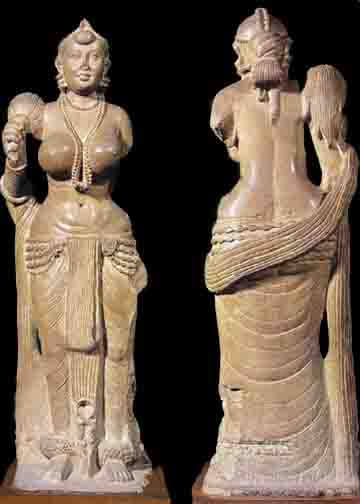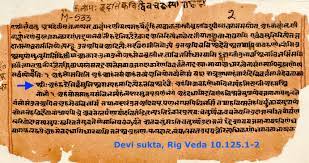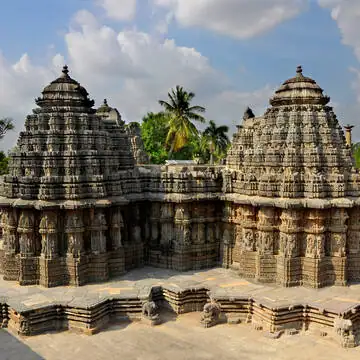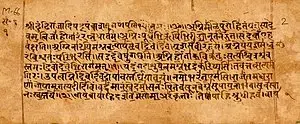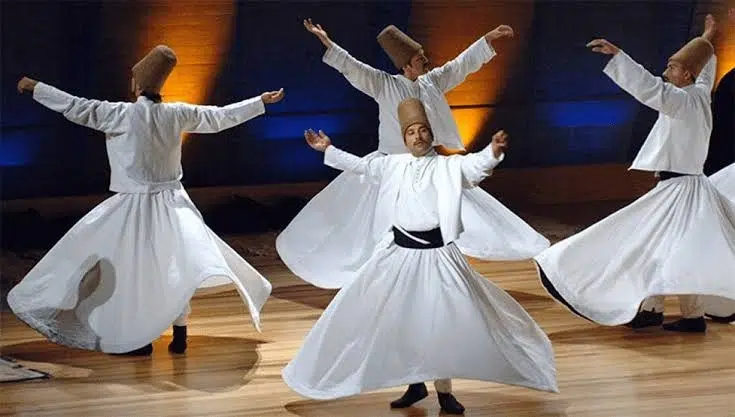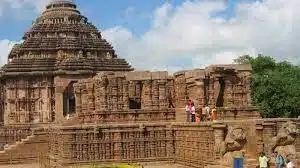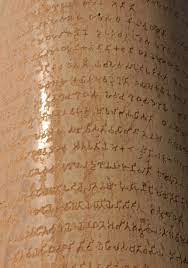GI Protected sarees of India
The natural fiber that is made of proteins and obtained primarily from silkworm cocoons is called silk. The largest producer of silk is China. India is the second largest producer of silk in the world, producing around 18% of the world’s total silk. There are five major types of silk of commercial importance, obtained from different species of silkworms. These are Mulberry, Oak Tasar & Tropical Tasar, Muga and Eri.
Each state of India has its own specialty and range of Sarees. Some of the specific varieties and notes about them for exams are as follows:
Kanjeevaram Silk and Saree
- Traditionally, the Kanjeevaram is a sari that is usually handwoven in mulberry silk and has pure gold or silver zari that renders it a festive quality.
- Originating from the village ‘Kanchipuram’ in Tamil Nadu, Kanjeevaram is considered the queen of silk sarees.
- The temple architecture of south India and especially around Kanchipuram has historically served as a mood board for design inspiration for the traditional Kanjeevaram motifs.
- One can spot motifs such as the mythical creature called the Yali (an elephant-lion fusion), the Ganda Berunda (a two-headed majestic mythical bird) and the ubiquitous temple border called reku.
- Tracing its long and rich history from the Chola Dynasty, Kanchipuram sarees today are considered as one of the oldest and rich legacies of the Indian textile industry.
- Kanchipuram silk has also received Geographical indication (GI Tag) in 2005-06.
- As per Geographical Indication (GI) label, a Kancheepuram saree should have 57 per cent silver and 0.6 per cent gold in zari. However, Tamil Nadu government has eased this to 40 per cent silver and 0.5 per cent gold to make life easy for its producers.
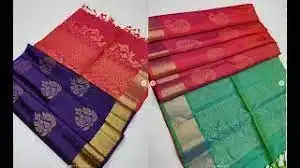
Banaras Brocade
- Banarasi brocade is in existence since Mughal era and can be identified with a narrow fringe like pattern, called Jhhalar, found along the inner and outer border.
- This fringe resembles a string of leaves.
- Banarasi Brocade is a GI protected item. As per the GI registry, brocade sarees made only in the districts of Varanasi, Chandauli, Mirzapur, Jaunpur, Bhadohi and Azamgarh in Uttar Pradesh can be authentically identified as Banarasi saree or brocade.
Paithani Sarees
- Paithani is a variety of sari, named after the Paithan town in Aurangabad Maharashtra state where they are woven by hand.
- Made from very fine silk, it is considered as one of the richest saris in India.
- Paithani is characterised by borders of an oblique square design, and a pallu with a peacock design.
- Plain as well as spotted designs are available.
- A pattan (Paithani) is a gold and silk sari.
- Paithani evolved from a cotton base to a silk base.
Chanderi Fabric
- Chanderi Fabric is a traditional sari made in Chanderi, Madhya Pradesh, India.
- It is characterized by its lightweight, sheer texture and fine luxurious feel.
- Chanderi fabric is produced by weaving in silk and golden Zari in traditional cotton yarn.
Uppada Jamdani Sarees
- Uppada Sari is a sari style woven in Uppada of East Godavari district in Andhra Pradesh.
- Uppada Jamdani saris are known for their lightweight.
- Jamdani is a ‘cotton’ fibre woven delicately into finest muslin. Jamdani weaving originated in India {modern Bangladesh}.
Kota Doria / Kota Jali
- Kota doria is one of many types of sari garments made at Kota, Rajasthan and Muhammadabad Gohna, Mau in Uttar Pradesh and its nearby area. Sarees are made of pure cotton and silk and have square like patterns known as khats on them.
- Originally, such sarees were called Masuria because they were woven in Mysore. Kota Doria was granted a G.I. in July 2005.
- Kota Doria is lightweight and transparent and are considered to be lightest cotton sarees in India.
Ilkal Saree
- Ilkal saree is a GI protected craft of India from Ilkal town in Bagalkot district of Karnataka.
- They are prepared using cotton warp on the body and art silk warp for border and art silk warp for pallu of the saree.
- Ilkal town was an ancient weaving center in Karnataka.
Balaramapuram Sarees
- Balaramapuram Sarees are prestigious and GI protected Saree produced in Balaramapuram in Thiruvananthapuram District of Kerala.
- This fabric is Kerala’s first handloom product to get GI protection.
- Balarampur is an historically important weaving place in Kerala where Kings of Travancore patronized the art.
Gadwal Saree
- Gadwal saree from Gadwal of Mahbubnagar district, Telangana is a GI protected variety of Saree.
- The saree consists of cotton body with silk pallu which is also given a new name as Sico sarees.
- The weavers design in such a way that it can be folded and fit in a matchbox.
Pochampalli Ikat
- Pochampalli Ikat is a saree made in Bhoodan Pochampally in Nalgonda district, Telangana State, India.
- Its uniqueness lies in the transfer of intricate design and colouring onto warp and weft threads first and then weave them together globally known as double ikat textiles.
- Pochampally saree received Intellectual Property Rights Protection or Geographical Indication (GI) status in 2005.
Salem Fabric
- Salem Fabric is a saree made out of silk yarn and cotton yarn and designed by using superior grade fabrics and advanced machinery.
- In 2006, Salem Fabric became the first GI product from Tamil Nadu.
Orissa Ikat, Odisha
- Orissa Ikat is a kind of ikat, a resist dyeing technique, originating from Odisha.
- Also known as “Bandha of Orissa”, it is a geographically tagged product of Orissa since 2007.
- It is made through a process of tie-dying the warp and weft threads to create the design on the loom prior to weaving.
Kuthampully Sarees
- Kuthampully Saree is a type of Sari traditionally made by weavers from Kuthampully village in Thiruvilwamala Grama Panchayat of Thrissur district of Kerala state in India.
- The Kuthampully Saree is distinguished by its Saree borders.
- In 1972 Kuthampully Handloom Industrial Cooperative Society was registered with 102 members. Now it has 814 members with own building in Kuthampully.
- In September 2011, the Kuthampully Saree got exclusive Intellectual Property rights through Geographical indication Act (GI).
Venkatagiri Sarees
- Venkatagiri Sari is a sari style woven in Venkatagiri of Nellore district in the Indian state of Andhra Pradesh. It was registered as one of the geographical indication from Andhra Pradesh by Geographical Indications of Goods (Registration and Protection) Act, 1999.
- Venkatagiri saris are known for their fine weaving.These style of saris can also be found in the villages of Sengunthapuram, Variyankaval, Elaiyur, Kallathur, Andimadam and Marudhur village.
Baluchari Saree
- Baluchar Sari or Baluchuri Sari is a type of sari, a garment worn by women across India and Bangladesh. This particular type of sari originated in Bengal and is known for depictions of mythological scenes on the pallu of the sari.
- It was mainly produced in Murshidabad but presently Bishnupur and its surrounding places of West Bengal is the only place where authentic Baluchuri sarees are produced. It takes approximately one week to produce one such sari. The Baluchari Sari has been granted the status of Geographical indication in India.
Maheshwar Sarees
- Maheshwar is a city in Khargone district of Madhya Pradesh. Maheshwari Saree is a cotton and pure silk fabric woven with zari or brocade in varied designs.
- The Maheshwari saree has special origin; it is traced by a queen who ruled over that territory.
- On the main part of the saree, it has checks, stripes, small butis or even plain body. Some sarees has reversible border, thus it can be worn either side.
Sambalpuri Bandha Saree
- Sambalpuri saree is a traditional handwoven ikat or sari or saree (locally called sadhi) wherein the warp and the weft are tie-dyed before weaving . It is produced in the Bargarh, Sonepur, Sambalpur, Balangir, district, Boudh District of Odisha.
- The saree is a traditional female garment in the Indian Subcontinent consisting of a strip of unstitched cloth ranging from four to nine metres in length that is draped over the body in various styles.
Patan Patola
- Patola are a double ikat woven sari, usually made from silk, made in Patan, Gujarat, India.
- The word patola is the plural form the singular is patolu.
- They are very expensive, once worn only by royalty and the aristocracy.
- They are popular and in demand from those who can afford them. Velvet patola styles are also made in Surat. Patola-weaving is a closely guarded family tradition.
- There are three families in Patan that weave these highly prized double ikat saris.
- It can take six months to one year to make one sari.
Khandua Saree
- Khandua saree a popular variety of silk Sarees, which is manufactured in Nuapatna in Cuttack district, has rightly been called the Pride of Odisha.
- The origin of this Saree, which is dedicated to Lord Jagannath of Puri Dham, dates back to 12th century.
- Khandua Saree is a classic example of hand weaving, in which traditional wooden looms are used to weave these exquisite and artistic pieces, out of pure tussar yarn produced by worm.
- Khandua Saree is granted Geographical Indications (GI) tag by Government of India.
State-wise list of GI Protected Sarees
- Bihar: Bhagalpur Silk
- Tamil Nadu: Kandangi Saree, Thirubuvanam silk sarees, Kovai Kora Cotton Sarees
- Uttar Pradesh: Banaras Brocade
- Karnataka: Ilkal Saree, Molakalmuru Saree, Udupi Sarees, Mysore Silk
- Andhra Pradesh: Uppada Jamdani Sarees, Venkatagiri Sarees, Mangalagiri Saree, Dharmavaram Handloom Pattu Sarres And Paavadas
- Kerala: Balaramapuram Sarees, Kasaragod Sarees, Kuthampully Sarees
- Telangana: Gadwal Saree, Pochampally Ikat (logo)
- Madhya Pradesh: Chanderi Saree, Maheshwar Sarees
- Odisha: Orissa Ikat, Bomkai Saree, Habaspuri Saree, Berhampur Patta (Phoda Kumbha) Saree
- West Bengal: Santipore Saree, Baluchari Saree, Dhaniakhali Saree
- Maharashtra: Paithani Sarees, Karvath Kati Tussar Sarees And Fabrics
- Chhattisgarh: Champa Silk Saree
- Gujarat: Surat Zari Craft, Patola Saree
- Assam: Muga Silk of Assam
Geographical Indications (GI)
- Geographical Indications in India are regulated by the Geographical Indications of Goods (Registration and Protection) Act, 1999 came in force with effect from September 2003.
- India had an obligation under TRIPS to pass a law for protection and regulation of geographical indications.
- Before this act, there was no protection in India for geographical indications.
- The present geographical indications regime in India is governed by the Geographical Indications of Goods (Registration & Protection) Act, 1999 and the Geographical Indication of Goods (Regulation and Protection) Rules, 2002.
Also, refer:

